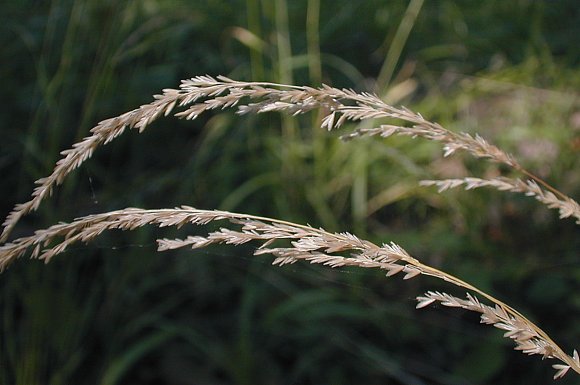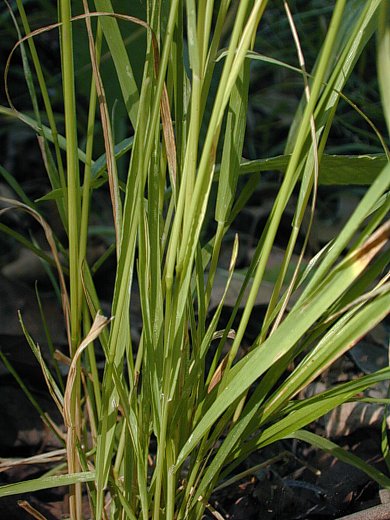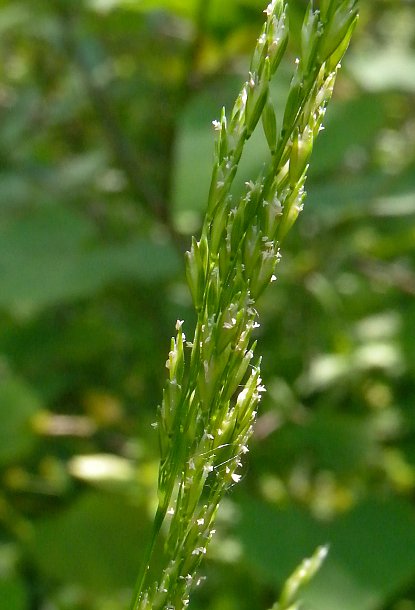Description: This perennial grass is 1½–3' tall, forming tufts of leafy culms that are usually erect to ascending. Each slender culm is terete, unbranched, glabrous, and light green to light tan. There are typically about 3-5 alternate leaves along the length of each culm. The leaf blades are up to ¼" (6 mm.) across and 5" long; they are light green to blue-green, ascending to widely spreading, flat to slightly furrowed, glabrous to sparsely short-pubescent, and rough-textured, particularly along their margins and lower surfaces. The open leaf sheaths are fairly tight, light to medium green, longitudinally veined, and glabrous to sparsely short-pubescent. The ligules are white-membranous, while the nodes are swollen, light green, and glabrous. Each culm terminates in a slender panicle of spikelets about 3-8" long. The slender lateral branches are up to 2½" long, occurring in whorls along the rachis of the panicle. These lateral branches are erect and appressed, ascending, or somewhat spreading.

The slender panicle usually nods to some extent, although sometimes it is straight. There is some variability in the length of the spikelets, glumes, and lemmas. Typically, each spikelet is about 3-4 mm. long, consisting of 2 glumes, 2-3 lemmas, and the perfect florets of the latter. The smaller (lower) glume is about 1.5-2.5 mm. long, linear in shape, and keeled; the larger (upper) glume is about 2-3 mm. long, oblanceolate-elliptic in shape, and convex to slightly keeled along the length of its outer surface. The lemmas are about 2.5-3.5 mm. long, elliptic in shape, and convex along the length of their outer surfaces (rather than keeled). Both the glumes and lemmas are hairless to slightly short-pubescent and they lack awns. The blooming period occurs during the late spring, lasting about 1-2 weeks. The florets are cross-pollinated by the wind. Shortly afterwards, the spikelets change color from light green to light tan. Disarticulation of the spikelets is below the glumes. Each mature spikelet produces 1-3 small grains that are linear-ellipsoid in shape. The root system is fibrous.

Cultivation:
The
preference is light shade to full sun, moist to slightly dry
conditions, and soil consisting of loam, clay-loam, or some rocky
material. This cool-season grass develops quickly during the spring and
becomes mature no later than mid-summer, after which it dies down.
Range & Habitat:
Slender Wedge Grass is occasional to locally common throughout Illinois
(see Distribution
Map), where it is native. Habitats include rocky woodlands,
open upland woodlands, areas along woodland paths, meadows in wooded
areas, gravelly seeps in partially shaded areas, and moist prairies.
Unlike the similar Sphenopholis obtusata (Prairie
Wedge Grass), Slender Wedge Grass is more often found in wooded areas
than prairies.

Faunal
Associations:
Very little is known about floral-faunal relationships for this small
genus of grasses. However, they are normally palatable to
hoofed mammalian herbivores (horses, cattle, elk, etc.), particularly
during the early stages of growth. Sometimes these grasses become
infected with an endophytic fungus that can make them somewhat toxic to
such herbivores. White-Tailed Deer seem to prefer other plants
(particularly many forbs) to wedge grasses (Sphenopholis spp.).
Photographic Location:
An upland area of Busey Woods in Urbana, Illinois.

Comments: Slender Wedge Grass (Sphenopholis intermedia) is somewhat unusual for a grass that is often found in woodlands because its strong bunching habitat is more typical of a prairie grass. Otherwise, its appearance is rather ordinary. Another scientific name of Slender Wedge Grass is Sphenopholis obtusata major. Under this taxonomic classification, the typical variety, Sphenopholis obtusata obtusata, is Prairie Wedge Grass. Slender Wedge Grass differs from the latter primarily by the shape of its larger (or upper) glumes, which are more narrow and pointed. The larger (or upper) glumes of Prairie Wedge Grass are obovate and nearly truncate; this latter grass is more often found in prairies than woodlands and its inflorescence tends to be more erect and spike-like. Because the spikelets of wedge Grasses (Sphenopholis spp.) disarticulate below the glumes, this makes them easier to distinguish from other similar grasses.